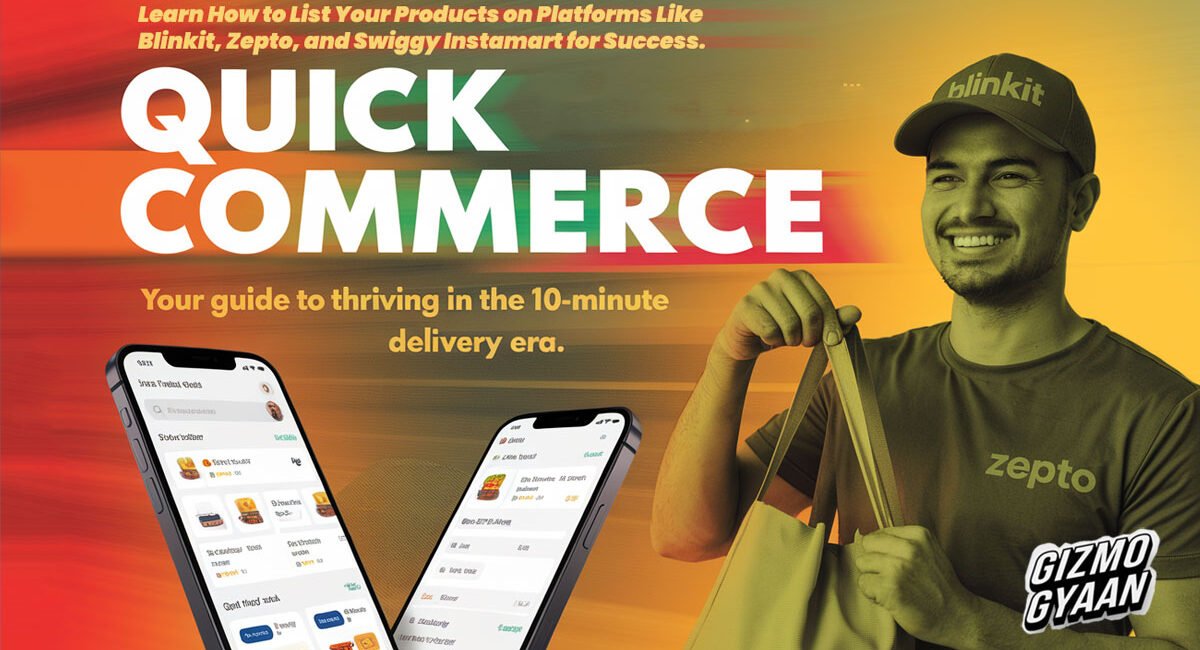In the age of instant gratification, quick commerce (q-commerce) has become a game-changer in India’s e-commerce landscape. Promising ultra-fast deliveries within 10–30 minutes, q-commerce caters to the growing demand for speed and convenience. For businesses, this opens up a lucrative channel to reach customers quickly and efficiently. This blog dives into why quick commerce is booming in India and how to list your products on these platforms.
What is Quick Commerce?
Quick commerce refers to platforms that deliver products—typically groceries, essentials, and fast-moving consumer goods (FMCG)—in record time, leveraging hyperlocal logistics and smaller warehouses. Unlike traditional e-commerce, q-commerce focuses on speed, fulfilling micro-orders with precision.
Why is Quick Commerce Growing in India?
- Changing Consumer Preferences:
- Indians, especially in urban areas, seek faster delivery for essentials.
- Rising disposable incomes and busy lifestyles contribute to this demand.
- Urbanization and Convenience:
- With nuclear families and working professionals, the need for quick restocking of groceries and household items is rising.
- Smartphone Penetration and Internet Access:
- The availability of affordable smartphones and data plans has made q-commerce platforms easily accessible.
- Expansion of Delivery Infrastructure:
- Investment in hyperlocal warehouses and rider networks has fueled rapid growth.
- COVID-19 Acceleration:
- The pandemic created a surge in demand for doorstep deliveries, solidifying the popularity of quick commerce.
- Competitive Landscape:
- With heavy funding from investors, platforms are vying to capture market share, offering lower delivery fees and discounts.
Popular Quick Commerce Platforms in India
Here’s a list of some leading q-commerce platforms in India:
- Blinkit (formerly Grofers):
- Focuses on groceries and everyday essentials.
- Delivery time: 10–20 minutes.
- Zepto:
- Known for its 10-minute delivery promise.
- Specializes in groceries, snacks, and beverages.
- Swiggy Instamart:
- Operated by Swiggy, it delivers essentials alongside food orders.
- Delivery time: 15–30 minutes.
- Dunzo:
- Covers groceries, medicines, and even parcel deliveries.
- Delivery time: 15–30 minutes.
- BigBasket’s BB Now:
- Quick delivery arm of BigBasket focusing on groceries and FMCG.
- Delivery time: 15–30 minutes.
- Amazon Fresh:
- Offers quick deliveries of groceries and fresh produce.
- Delivery time: 2 hours or less.
- Flipkart Quick:
- Covers groceries, electronics, and other categories.
- Delivery time: 90 minutes.
- UrbanPiper (Aggregator):
- Helps restaurants and retailers integrate with multiple q-commerce platforms for seamless listing and order management.
How to Place Your Products on Quick Commerce Platforms
- Research and Identify the Right Platforms:
- Assess your target audience and product categories.
- Choose platforms that cater to your niche (e.g., groceries, FMCG, or electronics).
- Meet Vendor Requirements:
- Register as a seller or vendor on the chosen platform.
- Provide business documents like GST registration, FSSAI certification (for food products), and bank details.
- Optimize Your Product Listings:
- Use clear images and accurate descriptions.
- Highlight key features like freshness, quality, and discounts.
- Leverage Local Warehousing:
- Collaborate with the platform to store your products in their hyperlocal warehouses for faster deliveries.
- Focus on Packaging and Delivery Standards:
- Ensure your products meet quality and packaging guidelines to avoid rejections or complaints.
- Invest in Promotions:
- Use platform-specific ads or offers to increase visibility.
- Offer introductory discounts to attract customers.
- Monitor Performance and Feedback:
- Track sales and customer reviews on the platform.
- Use feedback to improve your product quality or service.
- Collaborate with Aggregators:
- Partner with aggregators like UrbanPiper or Shiprocket to manage orders across multiple platforms.Tips for Success in Quick Commerce
- Focus on High-Demand Products: Essentials like groceries, snacks, beverages, and personal care items perform well.
- Keep Stock Levels Updated: Platforms prioritize vendors with consistent stock availability.
- Leverage Data: Use platform analytics to identify trends and popular products.
- Stay Competitive: Offer competitive pricing and promotions to stand out.
The Future of Quick Commerce in India
The q-commerce industry is poised to grow exponentially, with Tier 2 and Tier 3 cities joining the trend. Businesses that embrace quick commerce early can tap into a rapidly expanding market and secure long-term growth.
Whether you’re a budding entrepreneur or an established business, now is the time to explore the potential of quick commerce and position your products for success.







